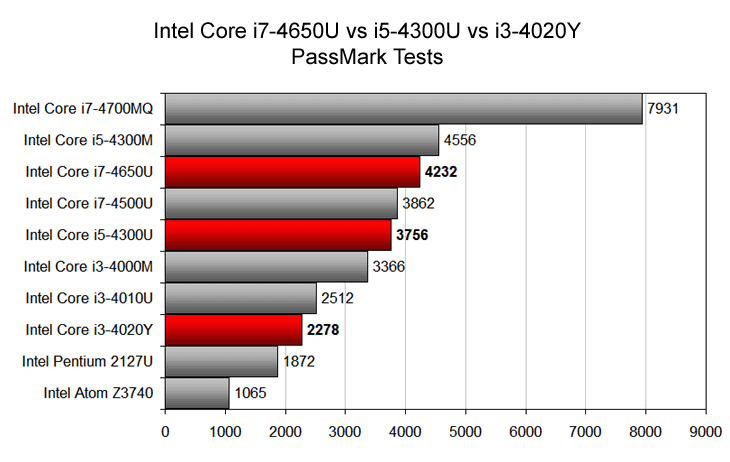 Although I believed the Intel Core i3 and i7 processors inside the Microsoft Surface Pro 3 tablet will be from the next generation Intel Broadwell chip family, it turned out that they’ll be actually the current Haswell chips. Namely the Intel Core i7-4650U and i3-4020Y. They will accompany the i5-4300U as the already known option.
Although I believed the Intel Core i3 and i7 processors inside the Microsoft Surface Pro 3 tablet will be from the next generation Intel Broadwell chip family, it turned out that they’ll be actually the current Haswell chips. Namely the Intel Core i7-4650U and i3-4020Y. They will accompany the i5-4300U as the already known option.
That’s according to CNet’s source at Microsoft. To remind you, the company announced the i5-4300U and unnamed i3 and i7 as the Surface Pro 3 CPU options. Since we now know thier SKUs – the i7-4650U and i3-4020Y – we can compare processors of the new tablet. At least their specifications and PassMark benchmark scores.
Naturally, the Core i7-4650U will be the fastest among the trio. It has some more advanced specs over similar i7 Haswells. The main is inclusion of the Intel HD 5000 series integrated graphics instead of the HD 4400. That should bring a bit faster graphics rendering, but still without big performance leap.
The i5-4300U is already in use in the Surface Pro 2. As a mid-range chip, it’s quite suitable for office and home tasks and is frequently used in various laptop and tablet models. It has the Intel HD 4400 IGP.
The Intel Core i3-4020Y is the slowest among them. Not just because the i3 is generally positioned lower in the CPU hierarchy, but also because of its lower power consumption. It’s an “Y” part with maximal thermal design power of 11.5 Watts, down from 15W of the “U” chips. Therefore, power-efficiency is the main selling point of this option. Hopefully, the i3 Surface Pro 3 will have a longer battery life than the i5 and i7. At expense of lower computing speed. The integrated HD 4200 IGP in it is a tad slower than the 4400 series.
Here are the benchmark results of these processors, taken from PassMark benchmark database. It contains test results of the processors used in various Windows-based laptop and tablet models available on the market.

The chart shows advantage of the i7, not only over the i5 and i3 Surface Pro 3 options, but also over the commonly used i7-4500U chip. Of course, the full-blown quad-core i7-4700MQ for high-performance and gaming laptops is far ahead. The i5 appears to hit the sweet spot between performance and cost, while the i3 is satisfactory for the most of home and office use scenarios. It should be avoided if you plan to use the SP3 mostly for demanding professional photo editing, video production or similar tasks. For these purposes, the i7 is recommended.
In the table below you can see the most important specifications points of the CPUs. The differences are highlighted in red color.
| Processor Name |
Intel Core i7-4650U | Intel Core i5-4300U | Intel Core i3-4020Y |
| Code Name | Haswell | Haswell | Haswell |
| Status | Launched | Launched | Launched |
| Launch Date | Q3’13 | Q3’13 | Q3’13 |
| # of Cores | 2 | 2 | 2 |
| # of Threads | 4 | 4 | 4 |
| Clock Speed | 1.7 GHz | 1.9 GHz | 1.5 GHz |
| Max Turbo Frequency |
3.3 GHz | 2.9 GHz | Not available |
| Cache | 4 MB | 3 MB | 3 MB |
| Instruction Set |
64-bit | 64-bit | 64-bit |
| Instruction Set Extensions |
SSE 4.1/4.2, AVX 2.0 | SSE 4.1/4.2, AVX 2.0 | SSE 4.1/4.2, AVX 2.0 |
| Lithography | 22 nm | 22 nm | 22 nm |
| Max TDP | 15 W | 15 W | 11.5 W |
| Recommended Customer Price |
TRAY: $426.00 | TRAY: $281.00 | TRAY: $281.00 |
| Processor Graphics |
Intel HD graphics 5000 |
Intel HD Graphics 4400 |
Intel HD Graphics 4200 |
| Graphics Base Frequency |
200 MHz | 200 MHz | 200 MHz |
| Graphics Max Dynamic Frequency |
1.1 GHz | 1.1 GHz | 850 MHz |
| Quick Sync Video |
Yes | Yes | Yes |
| Turbo Boost Technology |
2.0 | 2.0 | No |
| vPro Technology |
Yes | Yes | No |
| Hyper-Threading | Yes | Yes | Yes |
| Virtualization (VT-x) |
Yes | Yes | Yes |
| Virtualization for Directed I/O (VT-d) |
Yes | Yes | No |
| Intel TSX-NI | Yes | Yes | No |
| AES New Instructions |
Yes | Yes | Yes |
| Secure Key | Yes | Yes | Yes |
| Trusted Execution |
Yes | Yes | No |
| Execute Disable Bit |
Yes | Yes | Yes |
| Anti-Theft Technology |
Yes | Yes | Yes |
The most important difference between the i3 and other two parts is absence of TurboBoost technology on the former. That’s one of the causes of the lower benchmark scores of it. As already noted, another big difference is the lower TDP on the i3. Intel has also omitted some technologies important for business use on this chip, such as vPro system management. The i5 and i7 are pretty much similar, with graphics being the main difference.





















